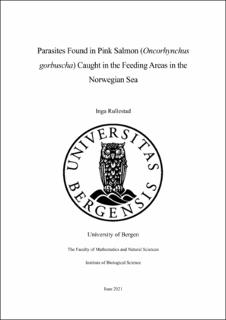| dc.description.abstract | The pink salmon (Oncorhynchus gorbuscha) is native to the North Pacific but has repeatedly been introduced to the North Atlantic by Russian researchers since 1956. This has resulted in the establishment of populations in north-western Russia and northern Norway. In 2017 pink salmon invaded at least 272 rivers along the whole Norwegian coast. This species, being alien to Norway, pose a potential risk to the native salmonids. Parasites have the potential to be used as indicators for feeding ecology, migration patterns and place of origin. However, the pink salmon exhibit anorexia when entering rivers to spawn, causing parasite loss. This reduce the information gainable from the parasites and complicates the interpretation. The aim of the present study was to investigate the parasite repertoire of pink salmon caught at sea, before parasite loss affects any patterns. Also, the occurrence of viral infections relevant to salmonid aquaculture was examined. A total of 86 pink salmon were caught in the Norwegian Sea by the Institute of Marine Research. The fish were examined for external and internal parasites and molecularly tested for microparasites and viruses. The pink salmon were found to be infected with 13 marine parasite species and Piscine orthoreovirus-1 (PRV-1). The parasite fauna of ocean-caught pink salmon consisted of four trematode species (Derogenes varicus, Brachyphallus crenatus, Hemiurus levinseni and Lecithaster gibbosus), six cestode species (Clestobothrium sp., Diphyllobothrium sp., D. schistochilos, Tetrabothrius sp., Clistobothrium sp. (Scolex pleuronectis type A) and Solex pleuronectis type B, two nematode species (Anisakis simplex and Hysterothylacium aduncum) and one crustacean species (Caligus elongatus). This study is the first to report the cestodes Tetrabothrius sp., D. schistochilos, Clestobothrium sp. and the sea louse C. elongatus from pink salmon. Most of the abundant parasites detected were food derived and could be contracted in feeding areas in the Norwegian Sea (A. simplex, Clistobothrium sp.), the Barents Sea or coastal shelves (D. varicus, L. gibbosus, H. aduncum) or particularly in Arctic waters (Diphyllobothrium spp.). Based on the finding of trematode parasites likely acquired in northern nursery areas (B. crenatus), it is suggested that most pink salmon originate in an area from Finnmark in Norway to north-western Russia down to the White Sea. It was also found that this indicator species, B. crenatus, was absent in fish over 1000 grams, thus a short parasite life span is likely responsible for its absence in river-caught pink salmon from western Norway. The pink salmon harbour many of the same parasites as wild Atlantic salmon, suggesting a high degree of diet overlap. The viral agent detected (PRV-1) is of little concern, infections are common in both wild and farmed salmon and usually benign. The zoonotic nematode A. simplex was detected in the muscle of 23 % of the pink salmon. Freezing kills the parasite and is therefore recommended before consumption, removing any risk of the disease anisakidosis. | |
